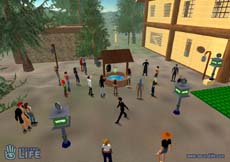index
Telephone calls don't make places
click on images for full-size:



Conversation in Second Life. (Image copyright 2003, Linden Research, Inc. All Rights Reserved.)

Gathering around the wishing well, in Second Life. (Image copyright 2003, Linden Research, Inc. All Rights Reserved.)
It might seem that virtual reality is a medium, but not a place. For example, people have conversations on the telephone, and they could get married during a conference call, but we do not think of telephone conversations as happening in a unified place separate from the locations of the people on either end of the line. When a committee meets by conference call the members do not think of themselves as meeting in some common place. If I converse with you by using instant messages that appear on each of our computer screens, there is no new place where our conversation is happening. All this is true, as far as it goes. But it does not follow that a participative virtual locale is the same as a phone call. A virtual locale becomes a place when it provides a perceived continuum that is divided into regions that hold a set of norms or expectations. It is not the visual connection that matters -- a video phone would not establish a new place. What matters is when sensory channels provide a continuous area that becomes a field of possible movements, so those movements and their sub-areas can be distinguished and laid open to norms and expectations. If, instead of voices coming over a conference call, I saw my committee members from the perspective of my virtual body in a virtual room, looking at the virtual bodies of the other committee members, and if I could virtually pound the table, or turn my back on the others, if the virtual space became differentiated into regions for talking and regions for looking away, if how I held my virtual body mattered in a way that my bodily position does not matter when I talk on the telephone, then the meeting would be taking place there in that virtual room. As norms and expectations make the area into a place, my sense of embodiment gives me the sense of being there. It is important that I see the virtual room from a point of view inside it, and be able to change that point of view. This puts my view inside the place. (For this reason video games such as Doom were an important advance because they allowed the maze of corridors to be seen in real time from the perspective of the actor whose "body" was both mobile and slightly visible to the player, if only as a gun barrel.)On the telephone I can be in my bathrobe, and with advanced virtual reality I could presumably also be in my bathrobe at home, but my virtual body might have to be properly dressed lest it violate some norm of the place. I might want to violate that norm for some reason, but it is the presence of the norm on the spatiality that makes the virtual area into a place.